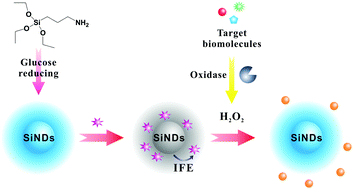One-step rapid synthesis of fluorescent silicon nanodots for a hydrogen peroxide-related sensitive and versatile assay based on the inner filter effect†
Abstract
In this work, a kind of environment-friendly and water-dispersible silicon nanodot (SiND) was rapidly synthesized by using the mild reagents (3-aminopropyl)triethoxysilane (APTES) and glucose. It was found that the fluorescence of the as-prepared SiNDs can be quenched obviously by permanganate due to the inner filter effect. Inspired by this finding, a novel fluorescent sensor for sensitive detection of hydrogen peroxide (H2O2) was developed through the oxidation–reduction reaction between permanganate and H2O2. The detection limit of H2O2 is down to 2.8 nM. Since H2O2 is an important molecule and involved in various studies, this sensor could be applied in various H2O2-related biological analyses. As a proof-of-application demonstration, a sensitive biosensor for glucose detection was constructed through the catalytic oxidation of glucose to generate H2O2. The as-constructed sensor showed good linear response to glucose over the range from 0.16 to 16 μM with a detection limit of 0.11 μM. Moreover, the biosensor can be readily extended to other sensors for different targets, which indicates the broad applications of the proposed sensing strategy in biomedical analysis.



 Please wait while we load your content...
Please wait while we load your content...